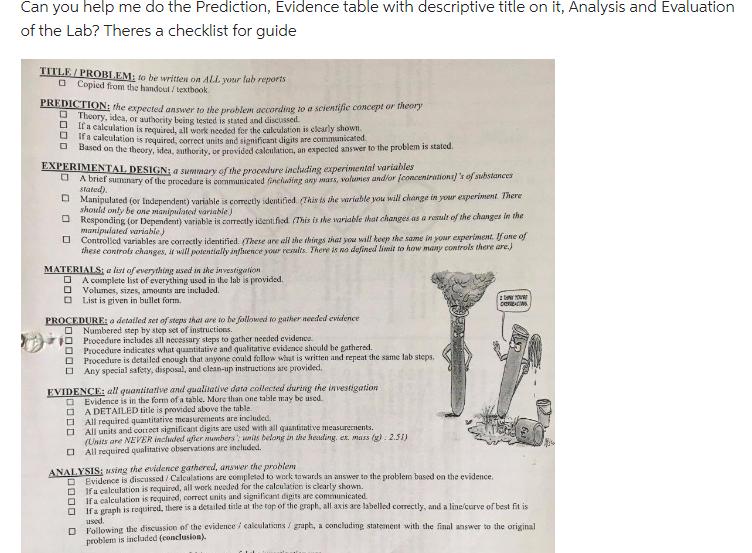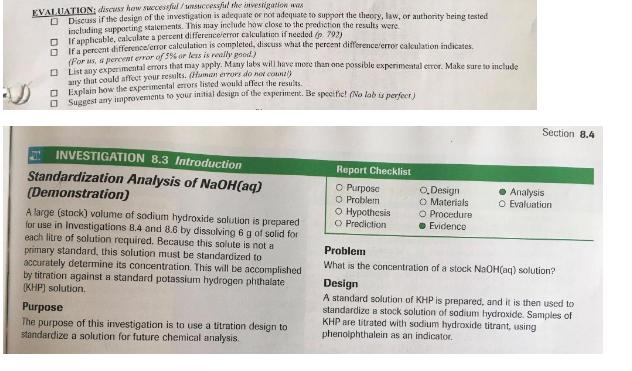Answered step by step
Verified Expert Solution
Question
1 Approved Answer
do the Prediction, Evidence table with descriptive title on it, Analysis and Evaluation of the Lab? Theres a checklist for guide TITLE/PROBLEM; to be


do the Prediction, Evidence table with descriptive title on it, Analysis and Evaluation of the Lab? Theres a checklist for guide TITLE/PROBLEM; to be written on ALL your lab reports Copied from the handout/textbook PREDICTION: the expected answer to the problem according to a scientific concept or theory Theory, idea, or authority being tested is stated and discussed. If a calculation is required, all work needed for the calculation is clearly shown. If a calculation is required, correct units and significant digits are communicated Based on the theory, idea, authority, or provided calculation, an expected answer to the problem is stated. O 0 EXPERIMENTAL DESIGN: a summary of the procedure including experimental variables A brief summary of the procedure is communicated (including any mars, volumes and/or concentrations]'s of substances stated). 0 Manipulated (or Independent) variable is correctly identified (This is the variable you will change in your experiment. There should only be one manipulated variable) Responding (or Dependent) variable is correctly identified (This is the variable that changes as a result of the changes in the manipulated variable) Controlled variables are correctly identified. These are all the things that you will keep the same in your experiment. If one of these controls changes, it will potentially influence your results. There is no defined limit to how many controls there are.) MATERIALS; a list of everything used in the investigation D A complete list of everything used in the lab is provided. 0 Volumes, sizes, amounts are included. List is given in bullet form. PROCEDURE: a detailed set of steps that are to be followed to gather needed evidence Numbered step by step set of instructions. Procedure includes all necessary steps to gather needed evidence Procedure indicates what quantitative and qualitative evidence should be gathered. Procedure is detailed enough that anyone could follow what is written and repeat the same lab steps. Any special safety, disposal, and clean-up instructions are provided. EVIDENCE: all quantitative and qualitative data collected during the investigation Evidence is in the form of a table. More than one table may be used. A DETAILED title is provided above the table. All required quantitative measurements are included. All units and correct significant digits are used with all quantitative measurements. (Units are NEVER included after numbers': units belong in the heading, ex. mass (g): 2.51) All required qualitative observations are included. YOU CCREACONS ANALYSIS: using the evidence gathered, answer the problem D Evidence is discussed / Calculations are completed to work towards an answer to the problem based on the evidence. D If a calculation is required, all work needed for the calculation is clearly shown. O If a calculation is required, correct units and significant digits are communicated If a graph is required, there is a detailed title at the top of the graph, all axis are labelled correctly, and a line/curve of best fit is used. Following the discussion of the evidence / calculations / graph, a concluding statement with the final answer to the original problem is included (conclusion). EVALUATION: discuss how successful/unsuccessful the investigation was Discuss if the design of the investigation is adequate or not adequate to support the theory, law, or authority being tested including supporting statements. This may include how close to the prediction the results were If applicable, calculate a percent difference/error calculation if needed (p. 792) If a percent difference/error calculation is completed, discuss what the percent difference/error calculation indicates. (For us, a percent error of 5% or less is really good) List any experimental errors that may apply. Many labs will have more than one possible experimental error. Make sure to include any that could affect your results. (Human errors do not county Explain how the experimental errors listed would affect the results. Suggest any improvements to your initial design of the experiment. Be specific! (No lab is perfect) INVESTIGATION 8.3 Introduction Standardization Analysis of NaOH(aq) (Demonstration) A large (stock) volume of sodium hydroxide solution is prepared for use in Investigations 8.4 and 8.6 by dissolving 6 g of solid for each litre of solution required. Because this solute is not a primary standard, this solution must be standardized to accurately determine its concentration. This will be accomplished by titration against a standard potassium hydrogen phthalate (KHP) solution. Purpose The purpose of this investigation is to use a titration design to standardize a solution for future chemical analysis. Report Checklist O Purpose O Problem O Hypothesis O Prediction O,Design O Materials O Procedure Evidence Section 8.4 Analysis O Evaluation Problem What is the concentration of a stock NaOH(aq) solution? Design A standard solution of KHP is prepared, and it is then used to standardize a stock solution of sodium hydroxide. Samples of KHP are titrated with sodium hydroxide titrant, using phenolphthalein as an indicator.
Step by Step Solution
★★★★★
3.49 Rating (152 Votes )
There are 3 Steps involved in it
Step: 1
The detailed ...
Get Instant Access to Expert-Tailored Solutions
See step-by-step solutions with expert insights and AI powered tools for academic success
Step: 2

Step: 3

Ace Your Homework with AI
Get the answers you need in no time with our AI-driven, step-by-step assistance
Get Started


